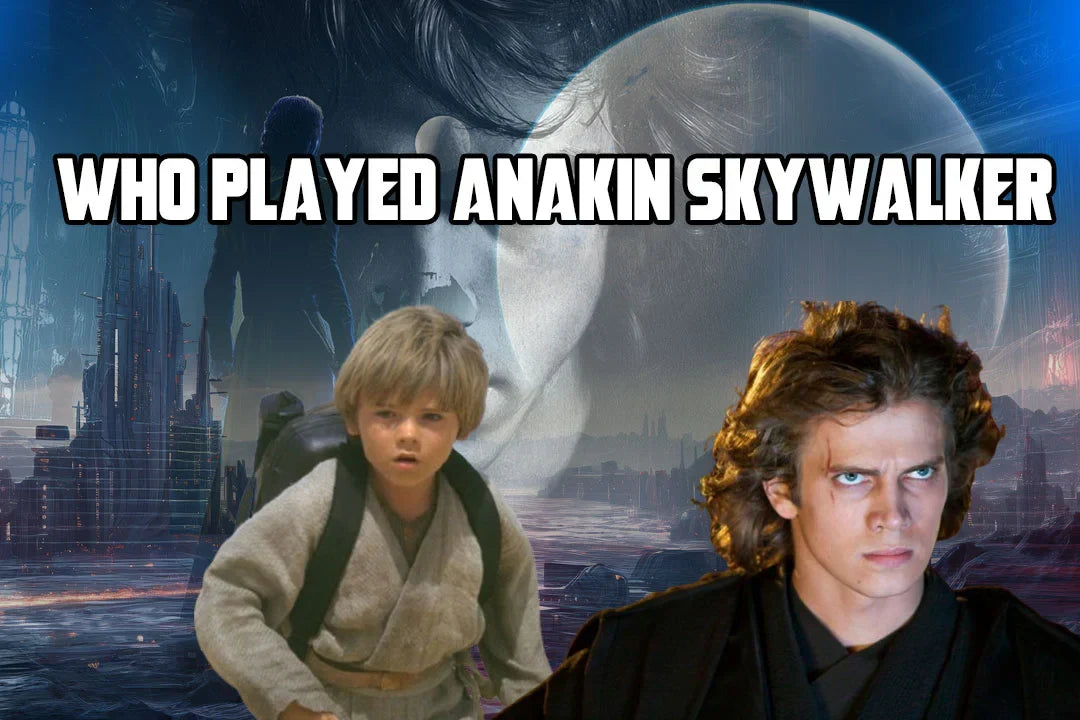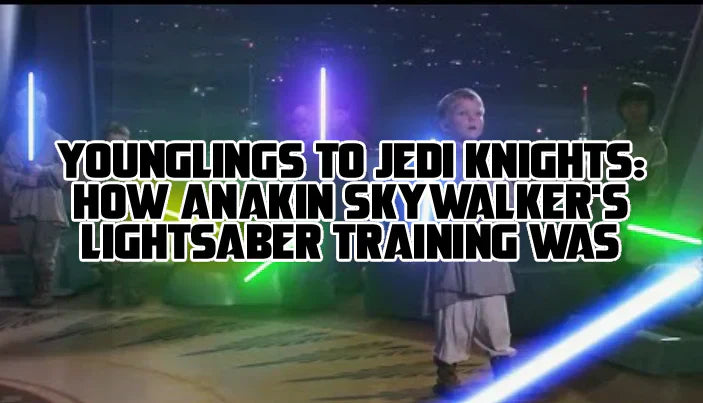In the vast universe of Star Wars, very few Jedi embody the intensity, sorrow, and complexity of Anakin Skywalker. He began on Tatooine as a hopeful and gifted child. He later transformed into Darth Vader after a turbulent journey as a conflicted Jedi Knight. His story is one of the most essential and emotional threads in the entire saga.
Across generations, several actors have portrayed Anakin. Each adds new layers to his evolution and deepens our understanding of the man behind the mask. In this blog, we’ll explore Anakin Skywalker’s canonical portrayals. We will focus on three defining performances that shaped his legacy:
- Young Anakin, portrayed by Jake Lloyd in The Phantom Menace
- Hayden Christensen’s tragic transformation in Attack of the Clones and Revenge of the Sith
- Hayden Christensen’s emotional return in Obi-Wan Kenobi and Ahsoka
From an optimistic boy to a fallen hero haunted by his past, Anakin’s transformation defines his personal journey. As well as the very heart of the Star Wars mythos.
Chapter 1: Jake Lloyd's interpretation of The Phantom Menace

Anakin Skywalker shows up as a nine-year-old youngster in The Phantom Menace (1999). A rare glimpse into his existence before meeting the Jedi Council. Viewers learn from these scenes about his early years, the basis of his personality, and the beginning of one of the most sad journeys in Star Wars.
Jake Lloyd's depiction strikes a strong counterpoint with the darkness Anakin would eventually embrace. His acting shows Anakin as bursting with life, curiosity, and limitless possibilities. We start to notice the remarkable talents that distinguish him and the emotional wounds that suggest his destiny.
An Innocent Opening
Vivacious, friendly, and driven, Jake Lloyd's Anakin personifies the Chosen's promise and optimism. Born into slavery on Tatooine, he battles against terrible conditions while yearning for freedom and the stars. The instant he meets Qui-Gon Jinn, Padmé Amidala, and Jar Jar Binks, he offers assistance with no ounce of hesitation. His compassion is clear and provides a view of the selflessness that defines him.
Anakin has exceptional instincts from an early age, particularly in Podracing. Canon emphasises his extremely high midichlorian count, which Qui-Gon thinks might prove he is the prophesied Chosen. Someone meant to restore force equilibrium. His racing success is due to his reflexes and awareness beyond conventional boundaries.
His mechanical brilliance sets him apart as another characteristic. Early indications of the engineering genius that would eventually shape him at only nine. He constructs C-3PO from junk and customises podracers outside of their usual capabilities. Darth Vader's droids, starfighters, and even his own armour. He shows bravery during the Boonta Eve Classic race by facing seasoned racers like Sebulba and never cowering, even in the face of risk. Directly influencing the Battle of Naboo, his ability later proves absolutely crucial when he annihilates the Trade Federation control ship. Therefore, demonstrating how his potential already shapes cosmic events.
Jake Lloyd's performance shows the Chosen One's bright side, not only as a gifted youngster but also as a person full of potential. His depiction lays the emotional base upon which Anakin's ultimate fall will be all the more tragic.
Fear of attachment
Although Lloyd portrays Anakin as happy and upbeat, delicate emotional cues forecast the impending tragedy. One of the most moving events of the film is his goodbye to Shmi Skywalker, his mother. His evident pain exposes ga reat attachment, a feeling that will define his ongoing conflict.
This early inability to release starts his internal struggle. Anakin's dread of losing loved ones, beginning with his mother, propels his future behaviour. His instinct to protect his loved ones conflicts with Jedi teachings emphasising detachment. Lloyd gently shows this, allowing spectators to feel the weight of what's coming without obvious signals. Early indications of the agony that will drive him toward darkness, every pause and look has fresh significance for those who know his fate.
Qui- belief that Anakin might be the Chosen One builds yet another layer of pressure. Though the boy lacks complete knowledge of the prophecy, expectations start to define his course. Long before he is ready to bear its weight, the notion of being "meant" for greatness gently circles him.
Why Jake Lloyd's depiction in canon matters
Though sometimes eclipsed by Hayden Christensen's subsequent performances, Jake Lloyd's performance is necessary for Anakin's narrative. It anchors the character and reminds us that Darth Vader was once an innocent, kind boy. His interpretation makes the major struggle of the universe. Anakin's descent into the darkness becomes personal, hence more human and sad.
We observe the beginnings of the characteristics that defined Anakin. His remarkable talent, bravery, and emotional depth, through Lloyd's performance. These make him both fragile and unique. The Phantom Menace helps us to grasp his voyage better. Transforming his change into Darth Vader into something both destined and immensely tragic.
Chapter 2: The Tragic Transformation: Attack of the Clones and Revenge of the Sith

Hayden Christensen represented Anakin's emotional struggle and disastrous decline, whereas Jake Lloyd portrayed the hopeful start of his life. Christensen portrays the gradual degradation of a gifted Jedi's ideals in Attack of the Clones (2002) and Revenge of the Sith (2005). A narrative propelled by love, worry, pride, and fraud. His performance reveals how the Chosen changes as fate and choice collide. One into the very force he once sought to destroy.
Anakin in Attack of the Clones (2002)
Ten years after the events of The Phantom Menace, Anakin, 19, serves in Attack of the Clones as Obi-Wan Kenobi's apprentice. Independent and strong but emotionally unstable and unprepared for the burden that comes with his abilities, Christensen depicts a gifted yet torn Jedi.
His feelings for Padmé Amidala start to take over his judgment during this phase of his life. His love for her becomes the emotional hub of his world, even though the Jedi Code prohibits attachment. A sincere reunion soon becomes an intense and obsessive relationship. Christensen skillfully shows a man caught between personal desire and Jedi responsibility, a struggle that forms the core of Anakin's demise.
The death of his mother exacerbates this conflict. Anakin goes uncontrollably in grief and rage when he finds she has been kidnapped and abused by Tusken Raiders. He kills the whole Tusken people, including women and kids, in one of the most distinguishing canon scenes. This is the first glimpse of Darth Vader inside Anakin, unrestrained wrath driven by pain. Though he feels shame and guilt, the act also feeds his bitterness toward the Jedi, whose teachings seem incapable of avoiding such agony.
Anakin's relationship with Obi-Wan is strong. But it starts to suffer as he starts to see his mentor as unduly critical and constraining. Christensen absolutely expresses the bitterness of a young man resentful of being held back by power. Driven by his anger and pride, their relationship widens. Making him open to manipulation. Especially from Chancellor Palpatine, who portrays himself as a friend and mentor.
Anakin lightsaber also reflects this inner struggle. The sophisticated and elegant blue-bladed weapon captures the picture of a Jedi Knight he yearns to become. Still, in his hands, it represents unrest, an instrument of revenge as well as justice. Every time he lights it, it bears the weight of his decisions and predicts the darkness that will quickly engulf him.
In Attack of the Clones, Christensen portrays Anakin as both a Jedi devoted to good and increasingly driven by desire, fear, and ego. This argument builds the emotional foundation for his inevitable collapse by highlighting a man confined between two worlds, unable to pick either without sacrificing something crucial.
Anakin in Revenge of the Sith (2005)
Through Revenge of the Sith, Christensen gives his most iconic performance. Once the impetuous pupil, Anakin is now a renowned war hero, but below the surface, he is more vulnerable than ever. Visions of Padmé dying in childbirth haunt him, so he starts to become consumed with stopping her death, seeing it as something he has to overcome rather than accept.
These visions signal the beginning of his ultimate fall. Suspicious of the Jedi Council, which he thinks withholds knowledge from him, Anakin instead seeks counsel with Palpatine. Pretending to care, the Chancellor skillfully manipulates him. Then slowly casts doubt on the Jedi. Anakin's desperation pushes him toward treachery when Palpatine reveals that the dark side can offer the power to cheat death.
Christensen's performance during this transformation is very emotive and subdued. He portrays a guy driven by fear and love. He was ready to give up everything he vowed to guard if it would rescue the one individual he could not live without. His choice to kneel before Palpatine and turn Darth Vader feels both startling and utterly unavoidable. This showed the product of years of inner turmoil and abuse.
The ultimate evidence of his fall, Vader Anakin directs the Jedi Purge, raids the Temple, and murders even the children. Once a symbol of heroism, his lightsaber becomes a blade of betrayal and death. Once defending the innocent, the same blue crystal now slashes down his brothers and pupils. His saber, through this reversal, comes to be a haunting symbol of how swiftly light may be directed toward darkness.
One of Star Wars' most memorable scenes is the confrontation with Obi-Wan on Mustafar. It is a terrible fight between brothers, not only a duel. Strikingly, Christensen catches Anakin's anger, pride, and feeling of betrayal; Obi-Wan's sadness highlights the depth of their link. The end of a friendship broken by tragedy is Anakin's loss, left torn and burning on the lava banks.
Anakin's near-death and resurrection as Darth Vader finish his metamorphosis. Christensen illustrates how love and optimism, distorted by dread, can transform a hero into a tool of annihilation. His subtle performance shows that Anakin's fall comes from despair rather than evil. Therefore, making his story one of the most everlasting tragedies in the Star Wars saga.
Chapter 3: Hayden Christensen’s Return: Ahsoka and Obi-Wan Kenobi

After nearly two decades, Hayden Christensen returned to the role of Anakin Skywalker in Obi-Wan Kenobi (2022) and Ahsoka (2023). His comeback not only revived nostalgia but also deepened the emotional legacy of the character. These appearances didn’t simply reintroduce Anakin. They completed his story. Showing how his past continues to echo through the lives of those he once loved and trained.
Obi-Wan Kenobi (2022): Facing the Ghost of the Past
In Obi-Wan Kenobi, Christensen’s portrayal of Darth Vader captures both the physical terror of the Sith Lord and the emotional ruin beneath the armour. The series bridges the years between Revenge of the Sith and A New Hope. Exploring how both Obi-Wan and Vader live with the pain of their past.
The fight on Mapuzo reintroduces Christensen as a menacing and relentless Vader. Every gesture speaks of anger and payback, but beneath the cruelty is a man still bound to his past. The scene becomes an emotional encounter rather than only a fight when Vader at last confronts Obi-Wan once more in the finale.
Christensen's eyes behind the shattered mask, half Anakin, half Vader, reflect the struggle between what is left of the Jedi Knight and what he has grown into. His voice, switching between his own and the mechanical distortion of the suit, reveals two spirits caught in one body.
For Obi-Wan, "Then my friend is truly dead," it is heartbreaking rather than just closing.
This encounter makes Vader more human than ever before. The audience discovers via Christensen's portrayal that Anakin's suffering didn't disappear with his change. Instead, it lay hidden under several layers of resentment and guilt.
Ahsoka (2023): The Apprentice and the Master
In Ahsoka, Christensen's reappearance has a more symbolic and spiritual shape. Appearing through the Force, he joins with Ahsoka Tano, his former Padawan, providing closure to both their tales.
Their confrontation on Earth Between Worlds reflects a last lesson rather than hostility. Here, Christensen's depiction of Anakin seems wiser and more well-balanced. Reflecting the redemption and peace discovered after death. The tone is in stark contrast to his previous performances; the once-tortured Jedi now acts as a teacher again. Guiding Ahsoka to embrace both light and dark as components of her legacy.
By this reunion, Ahsoka emphasises the everlasting link between master and pupil, one that exists even after death. Christensen quietly demonstrates how Anakin's spirit has healed, understanding replacing rage. His quiet demeanour mirrors the man he might have been had he not descended into darkness.
This look also fits a bigger story: it links together The Clone Wars, Revenge of the Sith, and the post-Return of the Jedi age. For long-time fans, it confirms that Anakin's narrative changed rather than ended with Vader's death. The salvation he obtained through Luke resonates over millennia, affecting those still walking his former route.
Therefore, Christensen's comeback turns into an identity recovery rather than a cameo. He sees Anakin as more than just the fallen hero; rather, as a mentor, father figure, and always-present Force.
Chapter 4: The Legacy of Anakin Skywalker and Hayden Christensen’s Impact

Anakin Skywalker's legacy goes much beyond the Star Wars movies. It captures every person's ongoing battle between light and darkness. Thanks to Hayden Christensen's portrayal, this struggle gains emotional depth and humanity, thereby turning Anakin from a mythic figure into a highly understandable person.
Chosen One Symbolism
The narrative of Anakin Skywalker is about destiny and the decisions that determine it rather than only about power and tragedy. Though his destiny as the Chosen One was to restore balance to the Force, that vision was never simple. Anakin most paradoxically achieved it via his fall and redemption: by destroying both the Jedi and the Sith, thus completely restoring the balance.
Christensen's account carries the burden of that fate. He demonstrates how pressure may cause greatness to collapse, how good intentions can warp into obsession, and how redemption can still arise from devastation. His Anakin reminds viewers that even in darkness, light can return, a message that is still at the heart of Star Wars' ethical basis.
A Performance Recharacterisation
Fans' initial reaction to Christensen assuming the part was split. While some found the tone and conversation of the prequels objectionable. Others misunderstood the vulnerability he brought to the character. Still, his perspective has been re-examined and much praised over time.
Looking back, Christensen's depiction seems vital for grasping Anakin's path. His ineptitude in Attack of the Clones mirrors a young man who is out of place in both the Jedi Order and the galactic environment. His intensity in Revenge of the Sith betrays an inner turmoil that words alone cannot convey. Together, they weave a complete emotional arc, the rise, fall, and ultimate redemption of one of film's most nuanced characters.
His comeback in Obi-Wan Kenobi and Ahsoka has reinforced that appreciation. Christensen not only returned to the part but also grew it, demonstrating Anakin's evolving spirit. Once thought of as a tale of failure, now it is one of healing for the character as well as for the audience members who grew up with him.
Beyond the Screen, a Legacy
The world of Star Wars still bears Anak's imprint. Luke, Leia, Rey, and even Ahsoka are all shaped by his decisions. Every one of them bears forward a segment of his path, the fight to do what is right despite temptation and fear.
Christensen's performance underpins this legacy. His work lends emotional believability to the main ideas of the tale: love, loss, redemption, and balance. He turned Darth Vader from a symbol of evil to a tragic character defined by emotion rather than just a threat by humanising a fallen hero. Christensen's comeback to the role has evolved from a nostalgic gesture to an acknowledgement of his ongoing contribution over time. His depiction joins prequels, sequels, and spin-offs into one emotional continuum and crosses Star Wars generations.
Hayden Christensen's Anakin Skywalker is finally more than just a tale of fall; it is one of reconciliation. His trip reveals that one can still discover peace and significance even after terrible disappointment. From his point of view, the Star Wars series reminds us that redemption is always within grasp, no matter how great the gloom may seem.
FAQS
Describe Anakin Skywalker's differences in age shown across the saga?
With subsequent interpretations, Anakin is nine years old in The Phantom Menace. Nineteen in Attack of the Clones. Twenty-two in Revenge of the Sith. Reflecting his days as Darth Vader and thereafter.
How does Ahsoka help Anakin Skywalker leave behind more legacy?
Anakin appears in Ahsoka's World Between Worlds, guiding his former Padawan and assisting her to come to terms with her history. Therefore, strengthening his impact even after his death.
For Anakin's character, what renders the last confrontation in Obi-Wan Kenobi noteworthy?
This confrontation revealed Anakin's permanent surrender towards the dark side. Obi-Wan accepted letting go of his guilt fully. These were the most emotional moments ever noted in the saga.
Why is Anakin Skywalker regarded as the central figure of Star Wars?
His choices shaped his fate as a Jedi and Sith. The main story tells us about Anakin's rise, fall and his redemption. Even more so, his fall affected the entire galaxy.




Leave a comment
This site is protected by hCaptcha and the hCaptcha Privacy Policy and Terms of Service apply.